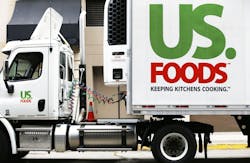US Foods aims to reduce Scope 1 and 2 GHG emissions by 32.5% by 2032
US Foods has submitted its targets to reduce greenhouse gas emissions to the Science Based Targets initiative (SBTi) for approval.
The goals US Foods is pursuing include:
· A 32.5% reduction in Scope 1 and 2 GHG emissions by 2032 from the 2019 base year
· Ensuring science-based targets set by 35% of its suppliers, covering 71% of its purchased goods and services, by 2027
Steps it plans to take to reduce emissions include a reduction in miles driven, new vehicle technology deployment and investing in alternative fuels, like compressed natural gas, renewable natural gas and renewable diesel fuel. It plans to add 30 electric trucks to its fleet by 2023 and continue expanding its EV fleet further to reduce Scope 1 emissions. It will also optimize its building operations efficiency by investing in renewable energy, like solar array and energy-efficient equipment and technologies deployment.
To reduce its scope 3 emissions, the firm will work with suppliers to establish meaningful supply chain interventions to support suppliers in their climate action journey.
“These ongoing investments are a testament to our dedication to reducing our organization’s environmental footprint,” said Kristin Coleman, executive vice president, general counsel and leader of CSR at US Foods. “The expansion of our facility and fleet efficiency initiatives are a critical part of US Foods’ long-range sustainability plans to drive end-to-end change.”
Environmentalists official define Scope 1 and 2 has emissions coming directly from company operations. These can be pollution created by an industrial plant, company vehicles or office operations, known as Scopt 1, while Scope 2 could be the emissions from power generation or electricity puchased by the reporting company.
Scope 3 are indirect emissions from operations not owned by the company. Those can include upstream activities after the sale of a product or by suppliers.
Illinois-based US Foods is one of the largest grocery suppliers in the nation. It owns a multitude of subsidiary packing, produce, meat, restaurant distribution and warehousing operations with revenues approaching $25 billion annually.
About the Author
EnergyTech Staff
Rod Walton is senior editor for EnergyTech.com. He has spent 17 years covering the energy industry as a newspaper and trade journalist.
Walton formerly was energy writer and business editor at the Tulsa World. Later, he spent six years covering the electricity power sector for Pennwell and Clarion Events. He joined Endeavor and EnergyTech in November 2021.
He can be reached at [email protected].
EnergyTech is focused on the mission critical and large-scale energy users and their sustainability and resiliency goals. These include the commercial and industrial sectors, as well as the military, universities, data centers and microgrids.
Many large-scale energy users such as Fortune 500 companies, and mission-critical users such as military bases, universities, healthcare facilities, public safety and data centers, shifting their energy priorities to reach net-zero carbon goals within the coming decades. These include plans for renewable energy power purchase agreements, but also on-site resiliency projects such as microgrids, combined heat and power, rooftop solar, energy storage, digitalization and building efficiency upgrades.
